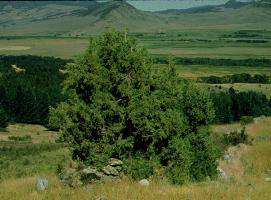The aromatic wood of this species is used for making cedar chests. It is also used for lumber, fenceposts, and fuel. Plantings are used for shelterbelts and wildlife habitat. In Nevada this plant is protected as a Christmas tree. Juniperus scopulorum is native to the U.S. and is in the Cupressaceae (Cypress Family).
Photo Credit: © Dr. R. Beall
Juniperus scopulorum
Common Name: Rocky Mountain juniper
Other Common Names: enebro ripario
Plant Functional Group: Evergreen conifer
Class > Order > Family: Pinopsida > Pinales > Cupressaceae
What does the species look like?
Juniperus scopulorum is an evergreen, perennial, coniferous tree. Its mature size is from 30 to 40 feet high with a spread of 3 to 15 feet. Rocky Mountain juniper often supports several main stems and has a rounded crown. Its bark is thin and reddish- brown but turns gray and usually sheds with age. Leaves are green or gray-green. The juvenile foliage consists of pointed, white-coated needles. The adult, scale-like foliage varies in color. Male (pollen) and female (seed) cones are on separate plants. Male cones are yellowish-brown, and mature female seed cones are round, dark-blue, and berry-like. The seeds are round and yellow-brown in color.
Rocky Mountain juniper prefers rocky or sandy hillsides, fields, pastures, and mountains. It is considered to be a low water- use species and prefers sun to light shade. It likes dry soil moisture and is tolerant of drought, cold, and salt spray. This species is slow-growing and does not like high humidity or high night temperatures. Its habitat can range from sea level to 9,000 feet in elevation. Its pollen is distributed mostly by wind, but also by gravity and water run-off.
Rocky Mountain juniper provides nesting sites, cover, and seeds for small mammals. In addition, iIt attracts a variety of birds such as waxwings, mockingbirds, grosbeaks, robins, and jays. It also attracts butterflies and is the larval host for the olive butterfly. Bighorn sheep, foxes, chipmunks, and other wildlife eat the berries.
Where is the species found?
States & Provinces
AB, AZ, BC, CO, ID, MT, ND, NE, NM, NV, OK, OR, SD, SK, TX, UT, WA, WY
Special Considerations for Observing
Note that individuals of this species with only male cones will not produce fruit
Which phenophases should I observe?
Do you see...?
Pollen cones
Pollen cones More...
How many fresh pollen cones are present?
Less than 3 3 to 10 11 to 100 101 to 1,000 1,001 to 10,000 More than 10,000
Open pollen cones What percentage of all fresh pollen cones (unopened plus open) on the plant are open?
Less than 5% 5-24% 25-49% 50-74% 75-94% 95% or more
Pollen release More...
How much pollen is released?
Little: Only a few grains are released. Some: Many grains are released. Lots: A layer of pollen covers your palm, or a cloud of pollen can be seen in the air when the wind blows
Seed cones
Unripe seed cones Juniperus scopulorum , an unripe seed cone is berry-like and green.More...
How many seed cones are unripe?
Less than 3 3 to 10 11 to 100 101 to 1,000 1,001 to 10,000 More than 10,000
Ripe seed cones Juniperus scopulorum , a berry-like seed cone is considered ripe when it has turned dark blue, purple or blue-black, often covered with a whitish film that rubs off.More...
How many seed cones are ripe?
Less than 3 3 to 10 11 to 100 101 to 1,000 1,001 to 10,000 More than 10,000
Recent cone or seed drop More...
How many seed cones have dropped seeds or have completely dropped or been removed from the plant since your last visit?
Less than 3 3 to 10 11 to 100 101 to 1,000 1,001 to 10,000 More than 10,000
What do these phenophases look like?
There is currently no photoguide available for this species. If you'd like help us create one, use the guidance document and species template provided here . Then send it via email to education@usanpn.org when it is complete.
